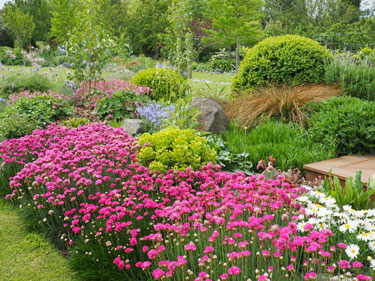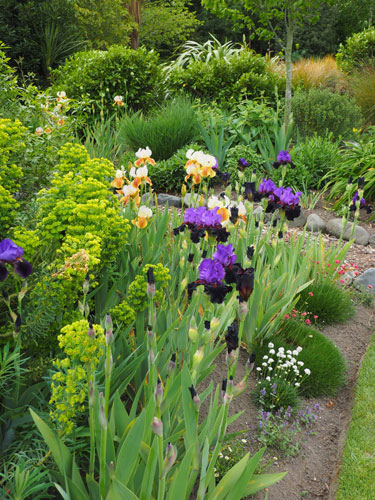Evolution of a gardener
Jenny Cooper and Chris Raateland have all the credentials of a successful gardening duo. Jenny is an award-winning artist, well known for her beautiful children’s book illustrations, and a very experienced gardener. Chris is a landscaping contractor. But eight years ago, when they moved to their 4600 sq m property in Amberley, it was the beginning of a brand new learning adventure.
The North Canterbury climate delivers a cocktail of challenges; freezing cold winters and wild windy springs, which can also be very wet, are followed by baking hot dry summers. The low summer rainfall is paired with very free draining soil. “I quickly realised my old gardening habits with endless watering and copious compost would be too hard to maintain in such a big garden,” says Jenny. “So I went on a digital journey, researching climate resilient plants and new ways to garden. I do feel that the climate situation is precarious, and I want to be more self-sufficient.” By trial and error and lots of research, she is adapting her planting style so the garden not only survives the long hot summer with little watering, but thrives.
The first challenge was the shocking ‘norwester’. After much research, Jenny and Chris planted quick growing native species in seven bands that fan around the property. Very small plants were planted at 30cm spacings so that they would establish quickly and provide temporary shelter for each other. When the quickest growers became too tall, Jenny began editing them out. Akeake were the first to go, then the pittosporums and lastly the tall flax bushes and griselinia.
As the shelter trees reach the end of their useful life, Jenny and Chris simply cut them off at ground level. “With their roots left in place and their branches turned into mulch, the original shelter trees now feed the soil to support new plantings,” explains Jenny. Perennial beds now thrive where windbreaks once grew and Jenny’s more desirable trees have grown large enough to temper the wind.
With shelter in place, Jenny could turn her problem-solving to developing a garden with minimal watering. “I want a beautiful, calm, resilient garden, which won’t break my heart in the five months of dry we often have,” she reveals.
For water management, the garden has distinct areas of high and low need. Water-dependent old favourites, like Jenny’s hydrangeas, hellebores and hostas, are grouped together in the shady wetter part of the garden. The vegetable garden takes the most watering.
“The productive garden takes as much work as the entire rest of the property even though it’s only one tenth the size,” laments Jenny. Here she experiments with different fruit and vege varieties to find those most suited to her conditions. Wherever possible, mechanical and cultural methods are used instead of spraying for pest control, including netting to keep birds and insects off their crops. Neem oil and Enspray99 control tomato thrip which prevails in the dry climate. Bacillus thuringiensis is used for biological control of caterpillars.
Generous composting and mulching go a long way towards conserving soil moisture, but watering is unavoidable if you want to grow vegetables in summer.
There is no such pampering for plants in the rest of the garden. Choosing the right plants for the right place is fundamental, but Jenny has found there is more than this to creating a beautiful garden in the dry. The key, she says, is understanding the soil and all that lives in it.
The blank canvas they started with was an undisturbed sheep paddock, with the original layers intact. Over the years, the pasture cover has added plenty of organic matter to the free draining sandy loam. Jenny is determined to protect the natural soil structure by keeping digging to an absolute minimum. And she works hard to keep bare soil covered, preferably with plants.
“We’ve learned that new garden beds don’t need turning in the old-fashioned way and we now only dig the holes needed for planting.” They convert lawn into garden beds by spraying or laying cardboard to kill the grass, then cover it with a thick layer of wood chip mulch. “As they break down into humus, the dead roots of the grass and the mulch feed the soil micro-organisms which in turn feed my plants,” explains Jenny. She sees her job as gardener is to grow the soil, rather than grow the plants.
Small grade plants are preferred at planting time. “The smaller the better, especially for trees,” she reveals. Planting small helps stretch the planting budget, but most importantly, Jenny wants the strong early root growth to happen in her soil rather than in a pot. “I try hard to capture the youthful vigour of my plants.”
She’s discovered that deep tap roots are well suited to surviving a dry spell but that these must be planted without delay, because plants can’t form tap roots easily in pots. Jenny does most of her planting in autumn or winter. This way her plants have time to recover from planting and grow healthy new roots before summer.
It’s tough love at planting time too. “I shake off the potting mix because I want the young roots in direct contact with my soil. Potting mix dries and wets at different rates from natural soil.” Initially it went against the grain, but Jenny says it’s been ‘very freeing’ to finally let go of the impulse to add fertiliser to the planting hole. “I leave it up to the mycorrhizal fungi and the other soil microbes to bring water and nutrients to my plants in exchange for carbon. Once a plant has mycorrhizal input, it is much more resilient to drought and fertilisers can inhibit mycorrhiza growth.”
She no longer wants the lush tall growth that comes from generous watering and feeding, saying “It was too much work to keep all that lush foliage upright, wondering whether to chop or prop after a big wind or rain. Since I changed the way I garden I’m enjoying a lower, slower, more robust kind of garden without all that soft vulnerable growth.”
Jenny’s favourite xerophytes include the classic mounding shapes of Mediterranean shrubs like lavender, rock roses, thymes, Ballota pseudodictamnus and Helichrysum italicum (curry plant). “I’ve learned to give these plants more space to spread. They claim their ground beautifully,” she says. Salvias and euphorbias are great for drought tolerance and summer colour.
Clump forming Salvia argentia is a real eye catcher with its big furry, silvery-grey leaves and white candelabra flowers. Shrubby South African Salvia aurea ‘Kirstenbosch’ is another favourite. Neatly rounded Euphorbia mellifera delights with its waxy foliage and brick red flowers. Euphorbia rigida puts on a show of chartreuse green flowers in winter and early spring. Tall accent flowers include Bupleurum with eucalyptus-like leaves and lime green flowers, and Baptisia with bright blue flowers and black seed pods.
Rather than cutting everything back at the end of summer, Jenny lets her plants stand until the middle of winter. “We allow the garden to soften and relax, enjoying the seedheads. Some might say it looks messy, but I love this time of year for its subtle golden colours and architectural shapes.”
A beautiful new covered pergola is the latest addition to the garden’s built structures, all provided by Chris. “He and his chainsaw are a crucial part of this garden,” says Jenny. It’s a large garden for a couple who both work full time, so there are some ‘rules’ to keep the workload down.
A once a year tidy up is okay, but plants that need constant deadheading or staking are given a miss. Of course, there are always exceptions, such as the Hammett Dahlias, which are more drought tolerant than any other dahlias Jenny has grown. She loves roses in other peoples’ gardens, which is where she goes to enjoy them.
Jenny considers ‘low maintenance’ a bit of a misnomer, saying, “I think a garden gives you back what you put into it, but I try to put my energy into jobs I enjoy.”
Among her greatest pleasures is researching plants and hunting them out. “I can’t resist finding new resilient plants to try. Often, I plant too much in a new area, as an experiment to see what will thrive, then edit out what doesn’t work. Ideally, I end up with fewer species to plant in higher numbers. Ultimately, I’m trying to simplify my planting, to make each area clearer in its intention.”
She loves the concept of matrix planting; repeating a palette of key plants with different shapes and textures, but which thrive in the same conditions. “I like the calmness and rhythm of the repeated forms.” On a visit to Southern France she admired the way huge deciduous trees grew over the top of the gardens. “It reinforced something I already suspected, that if you can’t give a plant water, give it shade. I came home and planted even more trees in my flower gardens.
I may have overdone it!” “It is all a big experiment, every week I learn something new.”
Blue House Amberley garden will feature in the Hurunui Garden Festival 2022, which runs from October 27 to October 30th. Jenny and Chris also welcome visitors by appointment. Phone Jenny Cooper on 0212589511 or find Blue House Amberley on Facebook or on Instagram bluehouse_amberley.

15-Sep-2022

Blue House Amberley garden
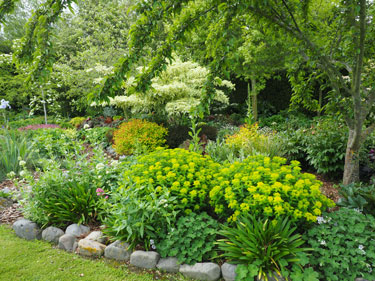
The lush green growth Jenny's garden in spring reveals no hint of the dry summer ahead.
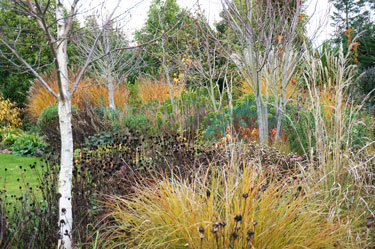
The garden in winter features golden Anemanthele and Miscanthus grasses, lime green Euphorbia wulfenii, brown Rudbeckia Goldsturm seed heads and white paper birch.
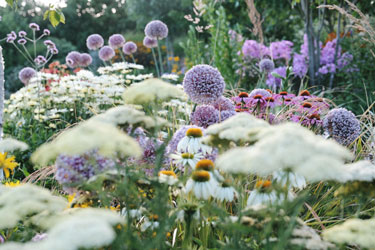
Dry survivors: Purple Allium, Echinacea, Verbena bonariensis, with white daisies and Achillea.
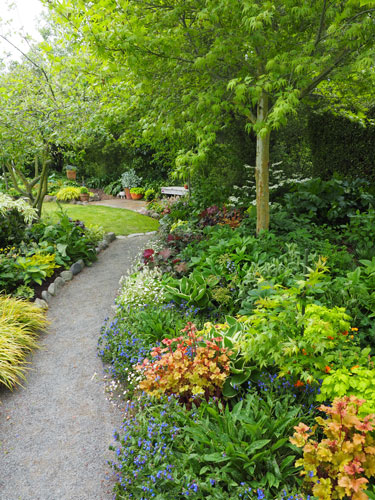
Heucheras add warm splashes of colour amid hostas and hellebores in spring.

Chris built the garden shed, and the covers to keep pests off the vege beds
